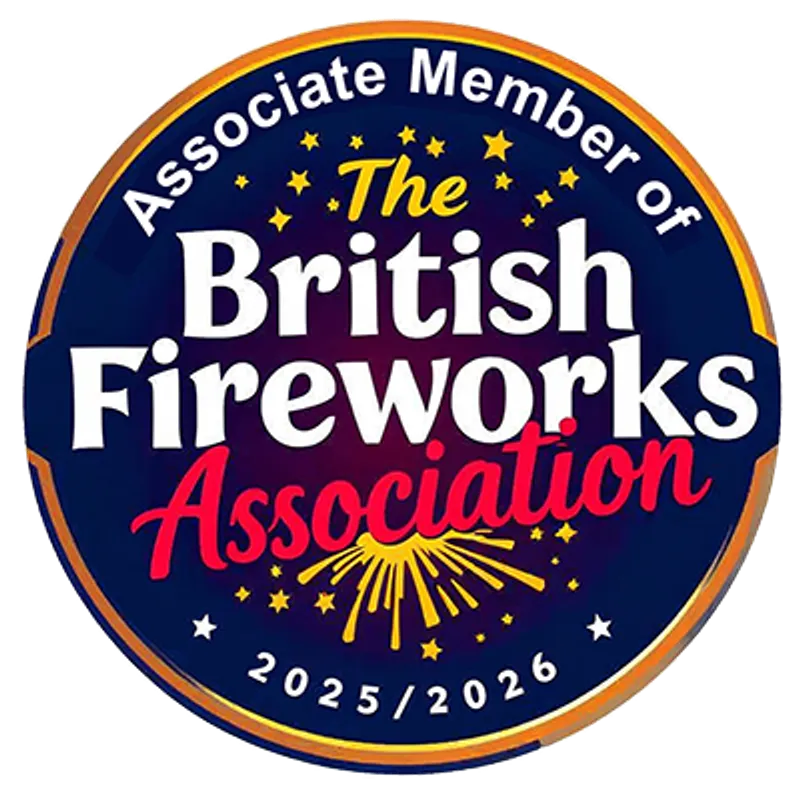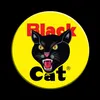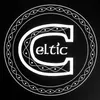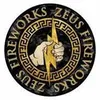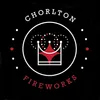UK Fireworks Statistics and Facts: The Definitive List
The magic of a cracking firework display is not to be sniffed at. From the god-level magnitude of the London New Year’s Eve firework display to the ones your uncle Steve is famous for choreographing with unmatched precision, we all have some fond memories of how fireworks punctuated a great night.
Fireworks are one of the best ways to make a party sparkle or to mark a special occasion like a wedding (or even a gender reveal these days). But they also come with safety warnings, and if you don’t follow firework safety laws, or worse yet, tamper with making your own fireworks illegally at home, you could end up in A&E. So, what does the general public think? We’ve investigated reports and surveys conducted about the use of fireworks in the UK and the general public’s attitude towards them. Let’s take a look at the facts and figures.
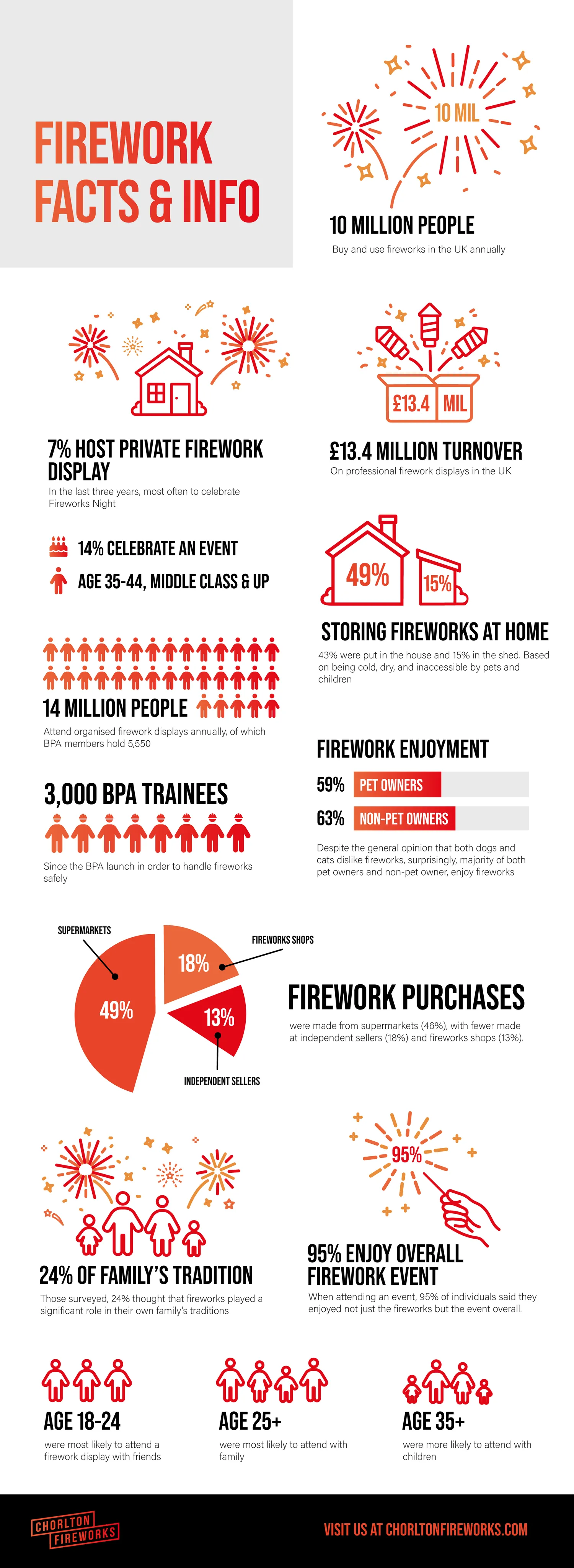
Buying Fireworks and Watching Displays
The British Pyrotechnics Association (BPA) represents professional fireworks display companies in the UK and is a central source of information and guidance for the display industry. A BPA briefing paper revealed the following statistics.
- 10 million people buy and use fireworks in the UK annually.
- The annual turnover on professional firework displays in the UK is approximately £13.4 million.
- Roughly 14 million people attend organised firework displays annually, of which BPA members hold 5,550.
- Over 3,000 individuals have undergone BPA training since its launch in order to handle fireworks safely.
The Association of Convenience Stores (ACS) estimates of the 46,262 convenience shops in the UK, 7% have licenses to sell fireworks. Holding a license is the only way a shop can sell fireworks outside of the traditional periods. The traditional periods are:
- 15th of October to 10th of November
- 26th of December to the 31st of December
- On the first day of Chinese New Year and three days after
- On the first day of Diwali and three days after
Of consumers purchasing fireworks, men made more purchases than women, and most purchases were made from supermarkets (46%), with fewer made at independent sellers (18%) and fireworks shops (13%). When storing fireworks at home, 43% were put in the house and 15% in the shed. Participants in the survey said their storage locations were based on being cold, dry, and inaccessible by pets and children.
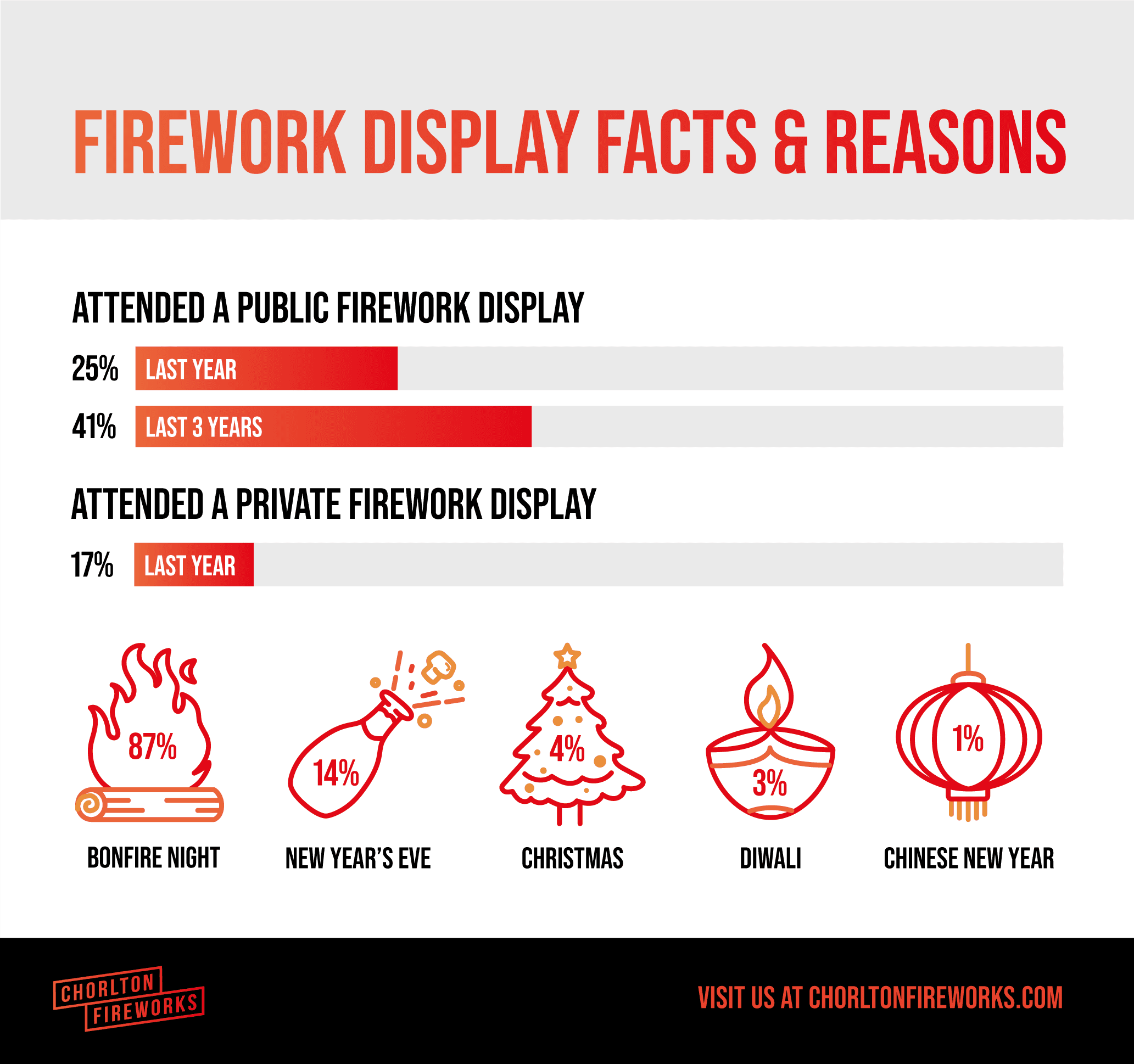
What do people in the UK think of fireworks?
The Office for Product Safety and Standards (OPSS) commissioned a report into the attitudes towards fireworks of the UK public, surveying a wide cross-section of people. This included ethnographic interviews with participants who attended public firework displays and participants who hosted private firework events, firework ‘rejectors’, industry stakeholders, and a survey of 1969 adults in the general population.
61% surveyed said they personally enjoy fireworks, and 45% had attended a firework display in the last year. One-sixth of survey participants had attended a private firework event in the last three years. Those who did not enjoy fireworks gave reasons related to distress, public safety, anti-social behaviour, and misuse of fireworks.
This chart shows the dispersion of opinions on the effect of both public and private fireworks displays.
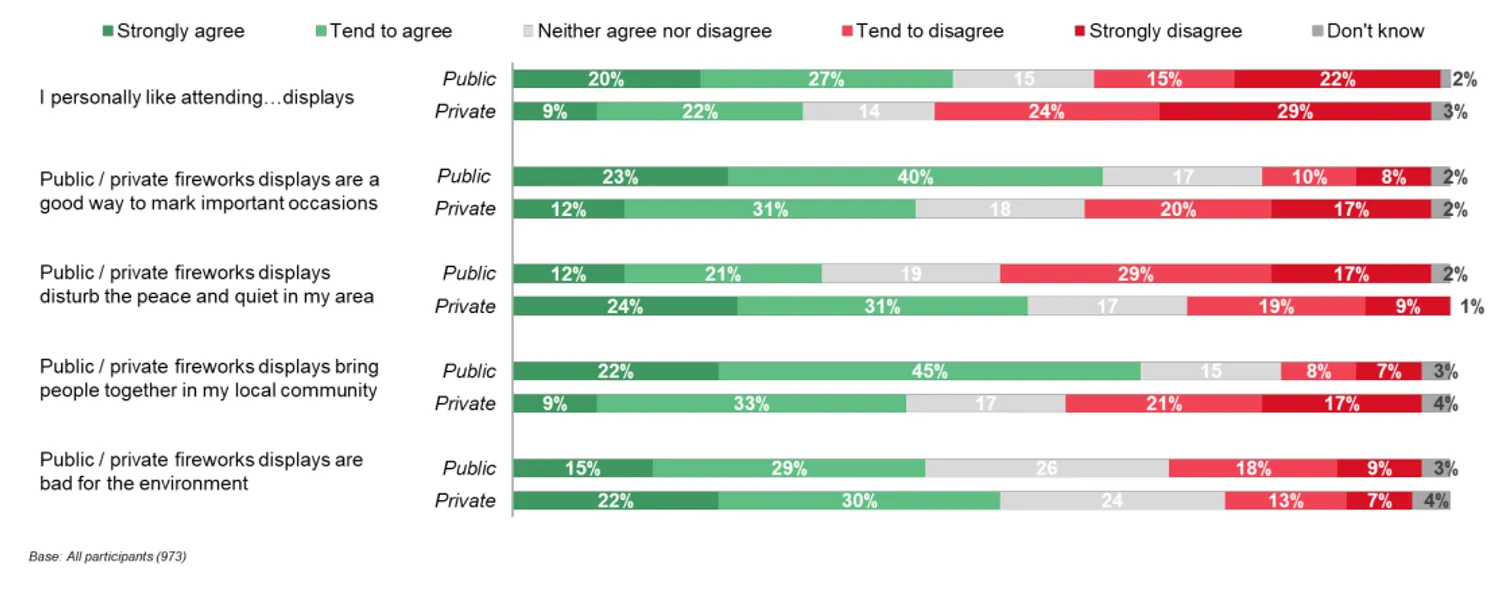
Image source: gov.uk
44% of individuals thought that fireworks are an important part of British culture, referencing Fireworks Night, New Year’s Eve, Chinese New Year, Diwali, and also Halloween. Participants in the ethnographic interviews stated that fireworks were mostly used for “key milestones in the lives of families and friends” and, to a lesser extent, used to mark religious holidays.
Fireworks were most popular among the under 44s and least enjoyed by those over 65. See the chart below for a representation of age groups and how much they said they enjoyed or didn’t enjoy fireworks.
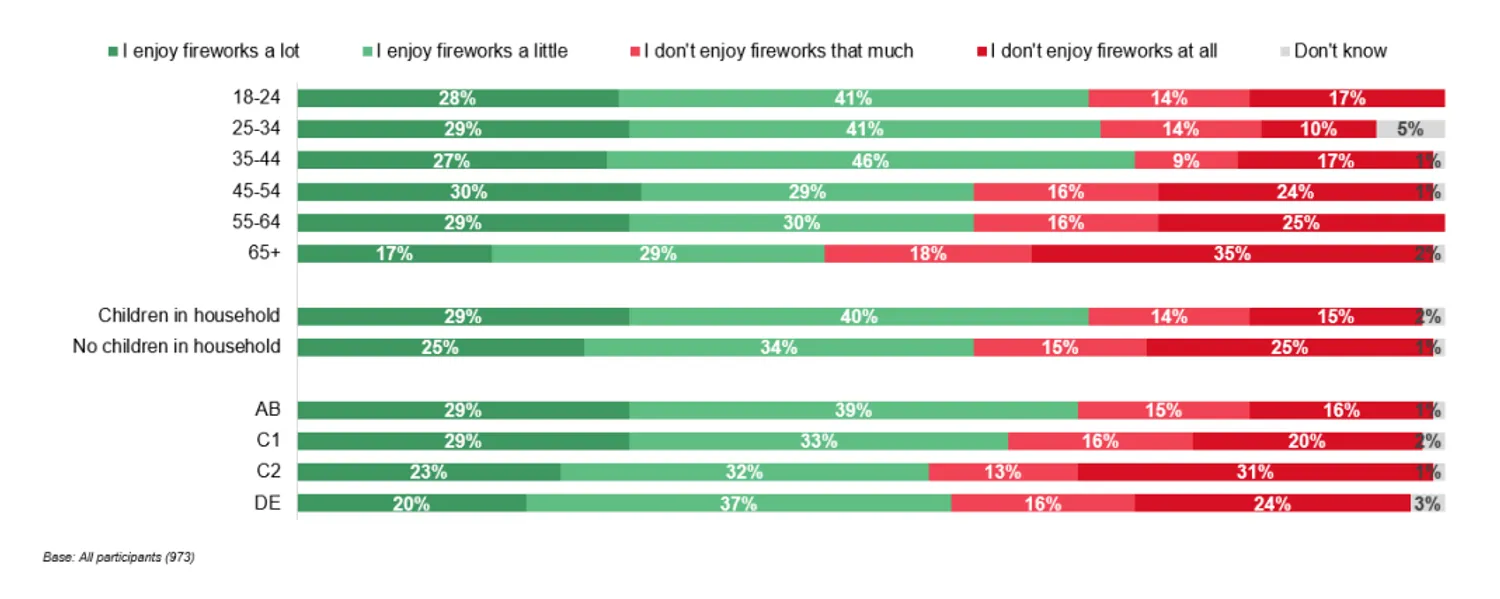
Image source: gov.uk
Despite the general opinion that both dogs and cats dislike fireworks, surprisingly, there was little difference between pet owners and non-pet owners, with the majority of both groups saying they enjoy fireworks (59% and 63%, respectively.
A survey on social media found that 24% of those surveyed thought that fireworks played a significant role in their own family’s traditions. Of different age brackets:
- 18-24s were most likely to attend a firework display with friends
- 25+ were most likely to attend with family
- 35+ were more likely to attend with children
7% of those surveyed had hosted a private firework display in the last three years, most often to celebrate Fireworks Night. 14% had been to celebrate an event such as a birthday or wedding. Those hosting private fireworks parties were most prevalent in social class AB (middle class and more affluent participants), aged 35 to 44, and had children.
When attending an event, 95% of individuals said they enjoyed not just the fireworks but the event overall.
The OPSS report included an observational study where attendees to a public firework display were observed for their reactions throughout the event. These are their findings:
- Participants were excited about purchasing snacks, soft drinks, and alcoholic drinks before the event.
- They hoped that the fireworks would be set off to music, noting that this increased the positive impact of the performance. However, it is noted that most fireworks displays do not use music.
- They expected there to be a bonfire and thought of this as a crucial aspect of a Firework Night display.
- Anticipation grew in the moments leading up to the display, with many checking their phones and watches for the time. They hoped the weather would be good to allow the event to run smoothly.
- When the display began, reactions were mixed. Most participants took part in the ‘ooh’s and ahh’s’ in reaction to the fireworks. There was a sense of togetherness, and participants were happy to be included in an event with a shared focus.
- Children enjoying and paying attention to the fireworks made participants happy.
- Participants anticipated the display building up to a crescendo.
- Some participants became bored, feeling the display went on for too long and checking the time to see when it would finish. They began chatting to determine when they would be ready to go home.
- Children became bored, particularly in the pauses between fireworks and would become distracted, counting stars, pointing out planes, and jumping in puddles.
- Pauses between fireworks made participants think the display had ended until they began to build up again slowly. This had the effect of frustrating spectators who were waiting for a final crescendo. One father was disappointed that the final firework was not loud enough.
The Significance of Fireworks in British Culture
In the last three years, 41% of people had attended a public firework display, and 25% had attended one in the last year. However, just 17% of those surveyed had attended a private display in the last three years. The reasons for attendance were:
- 87% for Bonfire Night
- 14% for New Year’s Eve
- 4% for Christmas
- 3% for Diwali
- 1% for Chinese New Year
Having interviewed thousands of participants, the OPSS report stated
“Participants from a range of backgrounds thought bonfire night was an important British tradition. It was referred to by different names: Fireworks Night, 5th of November, and Guy Fawkes Night. It was thought to be an important date in the calendar that signified the lead up to Christmas, which in turn, was associated with the gathering of families and friends at festive occasions. Children talked about learning about Guy Fawkes at school and drew pictures that families then displayed around the home.
Diwali, as an event in general, was thought to be instrumental in bringing families together. Celebrating families would invite friends and family to their home and offer traditional food and drink. Due to the nature of Diwali traditionally being hosted in the home, participants did not think going to a public fireworks event would be appropriate.
Chinese New Year was also considered an important way to bring the Chinese community together. Having a large event was important as it showed the strength of the Chinese community which they believed would attract more Chinese people and investment to their city.”
Firework Safety and Public Awareness
In its briefing paper on evidence regarding the safety of fireworks, the BPA stated that the UK has the best safety record of all European countries regarding firework displays and even going as far afield as The Middle East, Australia, and the US. It said that this was not based on elevated restrictions on licensing and venues but proper training of companies and firers along with a risk-based approach that respects performance parameters and the effects of wind, which can carry debris into hazardous zones.
In the OPSS report on attitudes to fireworks, participants in the ethnography felt that public firework displays were safer than private ones. In the general survey, 81% of people felt organised displays were safe, while 46% said the same about private displays. They reported that organised displays were safer because they were “planned and run by experts who made safety-driven decisions: this reassured them about safety at the event. They were also reassured by the presence of physical barriers to maintain public distance from fireworks, security checks at the entrance to the event, and the visibility of stewards.”
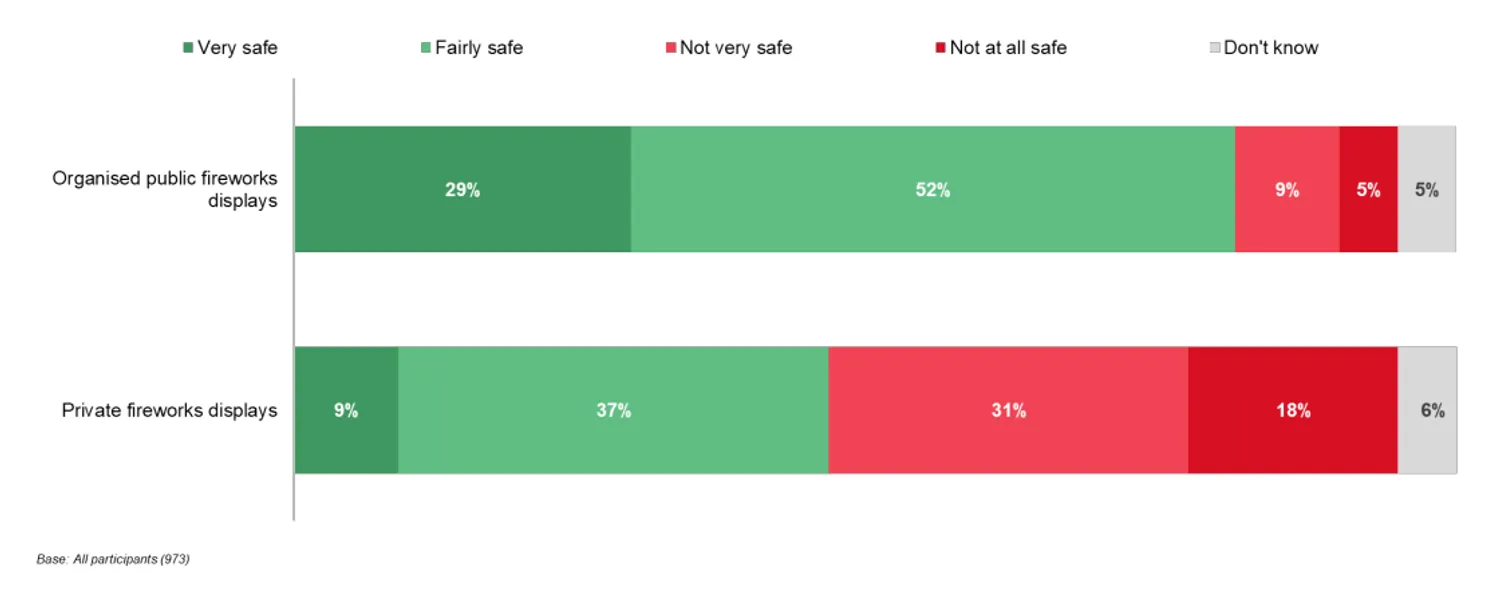
Image source: gov.uk
Safety behaviours observed at private events that caused discontent among the participants included failing to use the instructions and lighting fireworks with a lighter instead of the taper provided.
An e-petition in 2018 called for a ban on the sale of fireworks to members of the public. The OPSS conducted a Fireworks Evidence Base Report of fact-based research to determine whether the petition should be carried forward.
In its report, the OPSS reported that, according to RoSPA, 62% of individuals surveyed thought there wasn’t enough information publicly available, and 53% did not understand that CE marks on fireworks products demonstrate that they have met UK consumer safety standards. Looking for the CE mark on a firework is one of the best ways to check it is safe to use.
Together, the British Fireworks Association (BFA) and the UK Firework Review
Forum revealed that they had received 276 noise complaints related to fireworks.
The British Veterinary Association (BVA) and the British Horse Society (BHS) both reported incidents of injury or distress to animals caused by firework use, with the BHS receiving 272 reports between 2010 and 2019 and called for greater public awareness of the safe use of fireworks and the impact of fireworks on horses.
The Civil Aviation Authority ‘Firework Occurrence Summary’ from 2014 to 2019 reported 24 instances of ‘fireworks’ unlawful interference with an aircraft’—however, zero injuries.
What was the outcome of the report?
Following the report, the committee concluded a ban on fireworks was not necessary, and neither were further restrictions. It was clear from the evidence gathered that greater fireworks safety awareness was necessary. The committee posed that banning or further restricting the use of fireworks would only drive their use underground and exacerbate the existing risks.
It was determined that further work with animal welfare experts and a public awareness campaign would help reduce the hazards of incorrect or careless use of fireworks.
They also found that some fireworks being used did not adhere to the legal maximum 120-decibel level and that if operating instructions are followed and legal 120-decibel maximum fireworks are used, there should be no hearing damage. Nevertheless, they said that the government should promote silent and low-noise fireworks.
The committee also resolved to engage with local authorities to better understand the issues they face with fireworks and how to manage them. The British Pyrotechnists Association (BPA) and the CBI Explosives Industry Group provided information on the training of firework firers and local authorities to raise awareness and encourage investigation into risk management plans that are part of the overall event licencing regime.
The RoSPA Consumer Safety Product Awareness Programme Report stated that by working together with the OPSS on a fireworks safety campaign in 2018, they could deliver more in-depth information to raise awareness of public safety and the importance of enjoying fireworks responsibly and legally.
The bottom line is that fireworks always come with a danger warning, and if you don’t use them carefully, you could get hurt. That’s why we always wax lyrical about the safety precautions of firework use and ensuring you get your products from a reputable supplier like Chorlton Fireworks, a seasoned firework retailer that knows exactly what makes a good quality, reliable, and easy-to-use firework that anyone can enjoy.
350 Barlow Moor Rd
Chorlton
Manchester, M21 8AZ
07810 222123
info@chorltonfireworks.com
